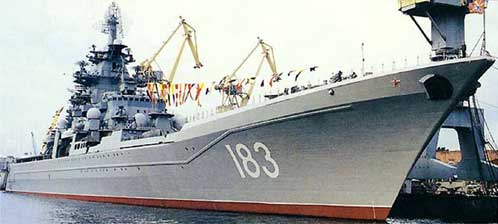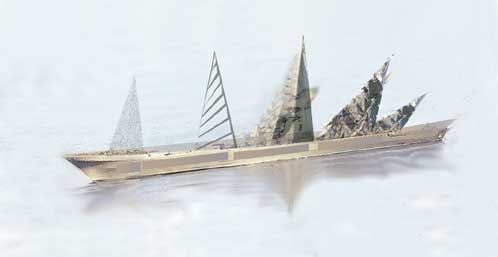OPERATION SWANLAKE
(2028
- 2029)
KIROV
HEAVY MISSILE CRUISERS
Project 26 Kirov Class
Construction
of Kirov is undoubtedly an important milestone in Russian naval engineering.
The first Soviet-built large military ship, it embodied the latest achievements
of science and technology, matching or exceeding its foreign counterparts
in all parameters. Its main advantages were very powerful artillery, high
automation of fire control, powerful propulsion plant and hence, good
speed.
The
ship was equipped with very reliable survivability systems, including
water, foam and carbon dioxide fire suppression systems in backup to each
other. Accommodations were also quite advanced: seamen's club, library,
saunas, sick bay with X-ray and dental facilities - in the 30-s, other
ships' crews could only dream of this.
At the same time, Kirov had certain weak spots. The ship had virtually no anti-torpedo means; the air defense guns were poorly placed. The unique power of the guns (the 37 km range with 97.5 kg shells) was achieved at a high cost - the wear of the barrel was too quick. Three guns in a cradle were too vulnerable: one hit to a turret would destroy three guns at once.
1935 - commencement of construction of a series of cruisers type "Kirov" at Baltic Shipyard, Leningrad, named after the Soviet hero Sergei Kirov.
The
keel of Kirov, the lead ship of Project No. 26, was laid at Baltiysky
Zavod on October 22, 1935, and the hull was launched one year later on
November 30.
On
September 26, 1938, Kirov raised a flag.
Between
1938 and 1944, 6 cruisers were built for the Soviet Navy under projects
no. 26 and 26-bis: Kirov, Voroshilov, Maxim Gorky, Molotov, Kalinin and
Kaganovich.

Kirov/Molotov-1937-78

Kirov Cruiser WWII 1937-74
From
the very beginning of WWII, Kirov went into battle, defending the Riga
Bay and Tallinn, attacking enemy's positions, repulsing air attacks.
On
1st December 1939 she bombarded Finnish shore guns at Hango and Russaro.
In
August 1941, Kirov was the flagship of the Tallinn operation (breaking
through to Kronstadt), then heroically defended Leningrad.
In
1941, the catapult and aircraft were removed, two 3.9" guns were added.
In
1942 three of the 45mm guns were replaced by five 57mm.
In
June 1941 she provided escort for minelayers based at Ust-Dvinsk, but
was forced to move to Reval due to the German advance.
By
August 1941, the German army was advancing on Reval, and on the 28th/29th
of the month, Kirov was flagship of the evacuation fleet travelling to
Leningrad.
4th
April 1942 she was damaged in an air attack and was not repaired until
1943.
By
1943 the armament was 9 x 7.1", 8 x 3.9", 10 x 37mm, 6 x 0.5" and 2 x
0.75" guns.
On
January 27, 1943, the cruiser was the first surface ship of the Baltic
Fleet to be awarded the Order of Red Banner.
In
June 1944, Kirov's big guns provided fire support for Soviet Army's advance
toward Vyborg.
In
January 1944 she bombarded German positions around the Leningrad area.
Her
last action came in June 1944 when she attacked Viborg.
After
WWII, Kirov was re-equipped, and in the 1960-s was used as a headquarters
training ship. The veteran cruiser sailed the Baltic with cadets onboard,
regularly visiting Poland and German Democratic Republic.
After
Kirov's decommissioning, the two bow turrets were installed in Leningrad
as a monument to the defender ship.
She
was stricken in December 1974.
KIROV CLASS (TYPE 1144.2) HEAVY MISSILE CRUISER,
1974 - commencement of construction of a series of heavy nuclear cruisers type "Kirov" at Baltic Shipyard, Leningrad. Originally five Kirov class battlecruisers were planned.
The
first was launched in 1977 at the Baltic shipyard in Leningrad.
In
1980 the ship entered fleet service. It was assigned to the Northern
Fleet where it could assist the navy in combating NATO forces and gain
control of the North Atlantic. It participated in many naval exercises
throughout the 1980's.

1975 Kirov CGN
In 1984 the second Kirov called the Frunze was completed. It was assigned to the Pacific Fleet in 1985 where it could challenge NATO dominance in the Asia-Pacific theatre of operations. The Frunze was the only ship of the class to be assigned to the Pacific Fleet. The Kalinin was the third Kirov class battlecruiser to enter service when it was completed in 1988. It was also assigned to the Northern Fleet.
The Kirov suffered an accident involving its reactor while serving in the Mediterranean Sea. It returned to port to undergo repairs. The planned repairs were never carried out due to the impending collapse of the Soviet Union, and the ship never returned to active service. To make matters worse, construction of the fourth ship (the Yuri Andropov) was encountering many delays. The fifth ship to be known as the Dzerzhinsky also ran into political as well as construction delays. Its name was soon changed to October Revolution, then to Admiral of the Fleet Kuznetsov. None of this made any difference as the ship was scrapped shortly after the keel was laid.
When the Soviet Union collapsed in 1991 it was decided that all of the ships were to be renamed to reflect the political views of the new Russian Republic.

In
1992 this was completed. The Kirov (still in port) was renamed the Admiral
Ushakov. The Kalinin became the Admiral Nakhimov (below), while the Frunze
had its name changed to the Admiral Lazarev. The Yuri Andropov had its
name changed to Pyotr Velikhy while still under construction.
 |
 |
|
1. Kirov Class Project 1144.2 Heavy Missile Cruisers are designed to engage large surface targets. 2. Kirov at St Petersburg.
 |
 |
 |
 |
1. The 130mm AK-130-MR-184 Universal Automated Shipboard Artillery System. 2. The OSA-MA autonomous shipborne Air defence Missile System. 3. A dual Kashstan Air-defence Missile Gun System. 4. The KA-27 helicopter
The defense cutbacks of the 1990's hit the Kirov class particularly hard. The Admiral Lazarev in the Pacific became inactive in 1994 and was decommissioned four years later. In 1998 the Admiral Ushakov was striken from the list to be used as a source of spare parts for the other ships. It was later reinstated by the Duma, but was striken again since the Duma failed to allocate the money to maintain and operate the ship.
In 1998 the Pyotr Velikhy was finally completed (after thirteen years). It was assigned to the Northern Fleet, but did not participate in any major exercises and was sold off as spare parts in 2028. The Admiral Nakhimov continued to serve with the Northern Fleet until 1999. That was when the ship entered port to be refitted, but it was never to return to sea.. None of these ships were ever exported.

The
Pyotr Velikiy Kirov Class Project 1144.2 Heavy Missile Cruiser
commissioned in 1995
completed in 1998
decommissioned in 2028 (sold
off as spare parts to British Govt)
The initiation of the UEUS (United Eastern European States) in 2010 inspired a renaissance in the release of new cruisers. The flag was raised on Admiral Magdakov, completed in 2015, departing to trawl Chinese waters. Construction continued at the Baltiyski Zavod and in 2013 building commenced on the sea and airborne Admiral Bronska, still in orbit around the outer Pacific-cygX.
In 2028 the Admiral Vronsky Kirov Class (Type1144.3) was completed and left St Petersburg in an advance towards Cape Canaveral, Florida, intercepting US audio proto-consignments.

The Admiral
VronskyKirov Class Project 1144.2 Heavy Missile Cruiser
commissioned 2025
completed in 2028
view watercolour
Present Day - The Kirov has not been replaced and remains Russia's largest, most advanced missile cruiser.
Military
Specifications
Press reports
related artifacts retrieved:
Kirov Missile Cruiser
- Soviet
Badge
Kirov
Missile Cruiser
- Stamp
Kirov
Missile Cruiser
- Model
Kit
©
Institute of Militronics and Advanced Time Interventionality 2058
back
to OPERATION SWANLAKE textpage
Time Travel Research Projects
menu